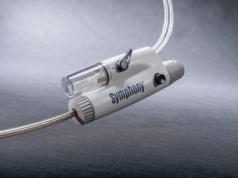 Imperative Care has announced US Food and Drug Administration (FDA) 510(k) clearance of its Zoom 6Fr insert catheters, the company’s latest innovation in elevating stroke care and—as stated in an Imperative press release—the first insert catheters developed specifically for ischaemic stroke procedures. The company also recently announced the successful completion of the first case with the Zoom 6Fr insert catheters, which was performed by Dana Tomalty at Huntsville Hospital in Huntsville, USA.
Imperative Care has announced US Food and Drug Administration (FDA) 510(k) clearance of its Zoom 6Fr insert catheters, the company’s latest innovation in elevating stroke care and—as stated in an Imperative press release—the first insert catheters developed specifically for ischaemic stroke procedures. The company also recently announced the successful completion of the first case with the Zoom 6Fr insert catheters, which was performed by Dana Tomalty at Huntsville Hospital in Huntsville, USA.
Based on physician feedback, the new Zoom 6Fr insert catheters were developed to be more supportive, more ‘torque-able’ and longer than current vessel selection devices, and are offered in three stroke-specific shapes. These features are designed for faster vessel selection and “uncompromised delivery” of Imperative’s comprehensive 0.088-inch intracranial access technologies—Zoom 88, Zoom 88 Support and Zoom RDL—to the intracranial anatomy.
“Insert catheters used for stroke today are diagnostic catheters that were designed for cardiovascular access more than 30 years ago,” said Ariel Sutton, general manager of Imperative’s Stroke Business. “The Zoom 6Fr insert catheters bring physicians the modern-day tools and technologies that will allow them the opportunity to best care for their patients, bridging the innovation gap of 30 years to today’s standards for stroke treatment. We are deeply committed to working closely with physicians to identify critical gaps in stroke care and providing innovative solutions that bring meaningful benefits to their patients. The introduction of the Zoom 6Fr insert catheters demonstrates our core tenet of clinical partnership, which puts the perspectives of front-line physicians at the centre of our research and development process.”
The Zoom 6Fr insert catheter portfolio consists of the Zoom SIM, Zoom VRT and Zoom VTK technologies—all, according to Imperative, unique in their shape, construction and length, with the goal of helping physicians achieve faster and more reliable intracranial access in a wide range of patient anatomies.
In the first case performed by Tomalty, the Zoom SIM insert catheter was used to quickly select the target vessel and provide 0.088-inch intracranial access from the femoral artery with Zoom 88 in a patient with a challenging anatomy and distal left M2 occlusion. The Zoom SIM provided added stability to navigate Zoom 88 far into the brain and access the clot more quickly. Tomalty then used both Zoom 71 and Zoom 35 to aspirate and remove the clot in only 10 minutes from puncture to reperfusion, resulting in a complete thrombolysis in cerebral infarction (TICI) 3 revascularisation.
“In my experience, navigating the aortic arch can pose a significant challenge in patients with more tortuous anatomy,” Tomalty said. “Due to the unique design and capabilities of the Zoom 6Fr insert catheters, I believe the use of these technologies will help mitigate this challenge and take minutes off my stroke thrombectomy times, allowing me to get the clot out faster.”










